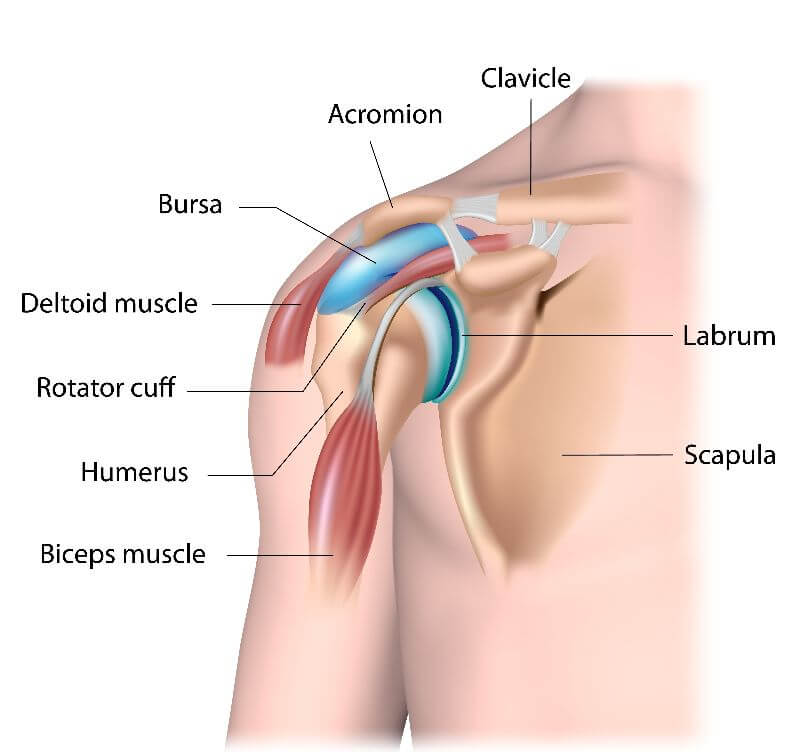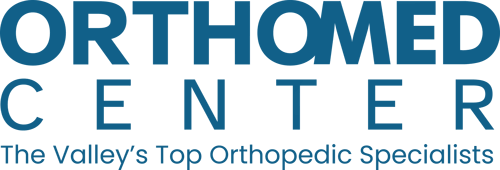Shoulder impingement refers to shoulder pain caused by mechanical irritation of one or more structures during shoulder motion. Shoulder impingement ranks as one of the top causes of shoulder pain. In impingement, the pain is not caused by an injury but by poor shoulder biomechanics that allows abnormal motion resulting in irritation and inflammation of the shoulder tissues. It is a persistent pain that affects everyday activities.
Your shoulder comprises several joints combined with tendons and muscles that allow incredible motion in your arm.
Your shoulder is made up of three bones: your humerus (upper arm bone), your clavicle (collarbone), and your scapula (shoulder blade).
Your arm is kept in your shoulder socket by your rotator cuff. These muscles and tendons form a covering around the head of your humerus and attach it to your shoulder blade.
There is a lubricating sac called a bursa between the rotator cuff and the bone on top of your shoulder (acromion). The bursa allows the rotator cuff tendons to glide when you move your arm.
If these many different structures don’t work well together, then shoulder pain may occur.
Shoulder impingement is often caused by:
- An irritated or swollen tendon due to repetitive activity of the shoulder, injury, or age-related wear and tear
- An irritated or inflamed bursa due to overuse of the shoulder or injury
- The development of age-related bone spurs on your acromion
While overhead athletes (swimmers, baseball players, tennis players) and people whose jobs require repetitive physical labor (construction workers, painters) are especially prone to developing shoulder impingement, shoulder impingement pain may occur without an apparent cause. Pain may also develop as the result of a minor injury to the shoulder.
If you have any of the following symptoms, call OrthoMed to set up a consultation with one of our orthopedic surgeons:
- Pain when lifting your arm, lowering your arm from a raised position, or when reaching
- Pain when your arms are extended above your head
- Pain and tenderness in the front of your shoulder
- Pain that moves from the front of your shoulder to the side of your arm
- Pain when lying on the affected side
- Pain or achiness at night
- Pain when reaching behind your back
- Weakness and stiffness in the shoulder and/or arm
During your consultation, your doctor will ask you questions about your medical history and questions about your shoulder symptoms, including
- What may have caused your shoulder pain?
- When did the pain begin?
- What have you tried so far to relieve your pain?
- Are you involved in repetitive activities that require overhead arm movement?
- Have you had any previous injuries to the affected arm/shoulder?
Your doctor will also conduct a physical exam of your shoulder to identify the location of pain and tenderness and assess your range of motion and arm/shoulder strength.
Additionally, your doctor will check x-rays of your shoulder to look at the bony anatomy and rule out other possible causes of shoulder pain, such as arthritis or calcification within the rotator cuff. He may also order magnetic resonance imaging (MRI) to identify possible injury to your rotator cuff or cartilage.
In most cases, initial treatment of shoulder impingement is nonsurgical. The goal of treatment is to reduce pain and restore function.
Although nonsurgical treatments such as these may take several weeks to months, many patients experience a gradual improvement and return to function.
- Resting and avoiding repetitive overhead activities.
- Icing the shoulder for 20 minutes once or twice a day.
- Taking over-the-counter anti-inflammatory medications (NSAIDs), such as Ibuprofen or Naproxen, to help reduce pain and swelling. These medications may have significant side effects, so speak with your doctor before starting an NSAIDs.
- Following a physical therapy program designed to help restore normal motion to your shoulder and improve range of motion (stretching exercises). If you have difficulty reaching behind your back, you may have developed tightness of the posterior capsule of the shoulder (capsule refers to the inner lining of the shoulder, and posterior refers to the back of the shoulder). Specific stretching of the posterior capsule can be very effective in relieving pain in the shoulder. Once your pain is improving, your physical therapist will start you on a strengthening program for your shoulder muscles.
- Having a cortisone injection (combination of a local anesthetic and cortisone preparation) may be helpful. Cortisone is a very effective anti-inflammatory medicine. Injecting it into the bursa beneath the acromion can relieve pain.
-
If nonsurgical treatment fails to relieve your pain, your doctor may recommend surgery. During surgery, your orthopedic surgeon removes the inflamed portion of the bursa to create more space for the rotator cuff. In some cases, he may need to remove a bone spur in your shoulder. Your doctor performs this procedure arthroscopically (small incisions with specialized instruments). He may also treat other conditions present in the shoulder at the time of surgery. These can include arthritis between the clavicle and the acromion (acromioclavicular arthritis), inflammation of the biceps tendon (biceps tendinitis), or a partial rotator cuff tear.
In an arthroscopic technique, your orthopedic surgeon inserts thin surgical instruments into two or three small incisions around your shoulder. He then examines your shoulder through a fiberoptic scope connected to a television camera and guides the small instruments using a video monitor.
After shoulder impingement surgery, your arm will be protected in a sling for a short time to allow for healing. Once you feel comfortable, your doctor will have you begin a rehabilitation program to regain shoulder range of motion and arm strength. Typically, it takes 2-4 months to achieve complete relief of pain.
If you would like to discuss shoulder impingement treatment with one of our orthopedic surgeons at OrthoMed, call (209) 524-4438 to schedule a consultation. For your convenience, you may also request an appointment online.




